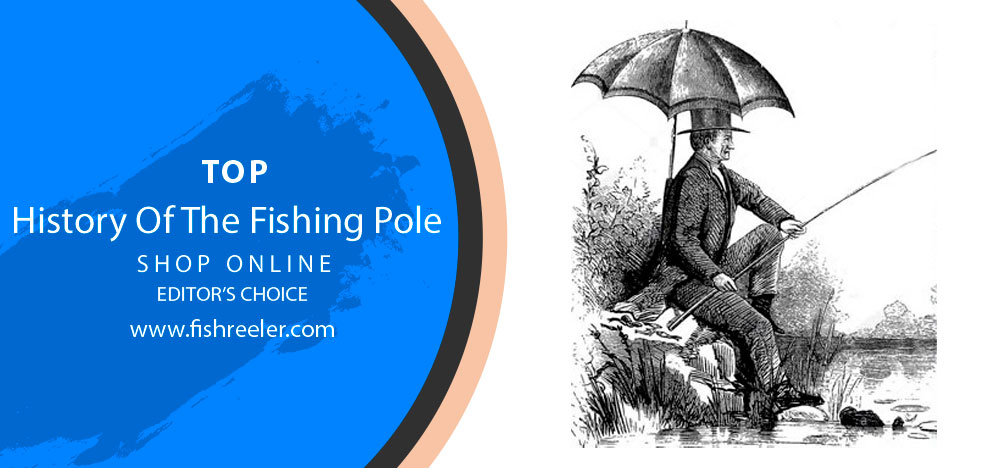
Casting Through Time: An Expert’s Guide to the History of the Fishing Pole

Hook, Line, and Sinker: The Unrivaled Importance of the Fishing Pole
Imagine heading out for a day of angling without your trusted fishing pole. Sounds impossible, doesn’t it? 💭 Over the centuries, the fishing pole has evolved from a rudimentary tool to an indispensable companion for both hobbyist and professional anglers alike. It’s an instrument that has transcended time and cultures, leaving an indelible mark on the history of human subsistence, leisure, and sport.
Whether you’re casting a line on a tranquil lake at dawn 🌅 or battling a marlin in the deep sea 🌊, it’s the fishing pole that stands between you and your coveted catch. Its invention and subsequent advancements have fundamentally transformed the art of fishing, making it more efficient, accessible, and enjoyable.
Setting the Bait: What to Expect in Our Deep Dive into the History of the Fishing Pole
In this captivating journey, we’ll travel through the corridors of time, unveiling the remarkable evolution of the fishing pole. From the primitive tools employed by our ancestors to the highly specialized rods of the modern age, we’ll explore the milestones that have shaped the history of this fascinating device.
Ready to bait your curiosity and hook some knowledge? 🎓 As we chart the course of the fishing pole’s past, we’ll discover the innovative minds that revolutionized angling, the materials that have marked each era, and the societal influences that have dictated its development. By the end of this expedition, you’ll be a veritable expert in the history of the fishing pole, able to appreciate not just the tool in your hand, but the centuries of progress it represents. Let’s cast off into this rich, winding narrative together! 🚀
Prehistoric Beginnings: Fishing’s Earliest Evidence 🦴
Catching the Past: Early Human Fishing Methods and Tools
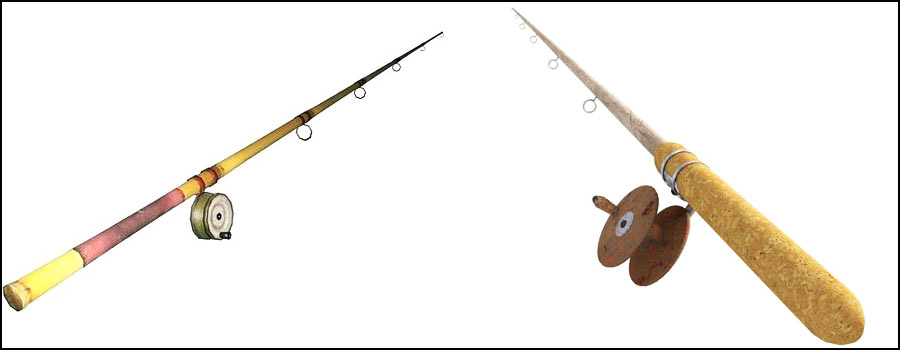
If we rewind the clock and venture back into the prehistoric era, we would discover our ancestors mastering the basics of survival. For them, fishing wasn’t just a leisurely pursuit but a vital means of sustenance. 🍖
Armed with rudimentary tools and a keen sense of intuition, early humans charted the waters in search of food. Fishing techniques were as varied as the cultures that employed them. From the simplest tactics, such as hand gathering and spearfishing, to more complex methods like weirs and fish traps, early humans utilized what was available in their environment to ensure a successful catch.🌿🐟
The earliest fishing tools were essentially extensions of the human hand, designed to enhance reach and lethality. Spears, nets, and lines made from plant fibres were common, with stone, bone, and shell often serving as hooks and weights. Yet, these primitive tools laid the groundwork for what would eventually evolve into the fishing pole.
Unearthed Treasures: Archaeological Findings of First Fishing Poles
Our understanding of prehistoric fishing is largely thanks to archaeological discoveries. 🕵️♂️ Artifacts like fish hooks, net sinkers, and even primitive rods found across the globe testify to the importance of fishing in early human societies.
One standout find was unearthed in Schöningen, Germany: a wooden throwing stick estimated to be about 300,000 years old. Although not a fishing pole in the strictest sense, it represents a significant step in the evolution of fishing tools, hinting at an increasing specialization of hunting equipment.
Primordial Tides: How Early Tools Shaped Fishing’s Future
The use of these early tools had a profound influence on the development of fishing. Each innovation, from the simple handline to the more sophisticated spear, expanded the possibilities for catching different types of fish in various environments.🌲🌊
Moreover, the invention of these tools spurred the growth of early human communities. As fishing methods became more efficient, groups could secure a more stable food supply, supporting larger populations and leading to the formation of permanent settlements near fertile fishing grounds.🏡🐠
These rudimentary tools and techniques are the bedrock upon which all subsequent fishing technology is built. As we’ll discover in the next chapter, a revolutionary material would soon be employed in the construction of fishing poles, marking a significant turning point in angling history… 🎋
The Age of Bamboo: The First Fishing Poles 🎍

Bamboo Rising: The Dawn of a New Fishing Era
Fast-forwarding to more recent history, a significant development marked the next evolution of the fishing pole: the introduction of bamboo. Stepping away from the previous rudimentary implements, humankind discovered a material that was both readily available and suitably durable. This shifted the course of fishing gear history, paving the way for the first fishing poles as we know them today. 🚀
Unlike the previous era’s tools, bamboo allowed for longer, more flexible rods that could bend with the weight of a fish, providing greater control and ease during fishing. Thus, began the age of bamboo—a transformative period in the timeline of fishing.
Strength in Simplicity: The Power of Bamboo in the Angler’s Hand
But why bamboo, you ask? 🤔 Simply put, bamboo presented a unique combination of properties that made it an excellent choice for rod making.
Firstly, bamboo was—and still is—plentiful in many parts of the world, especially in Asia, making it an accessible material. Secondly, bamboo’s inherent flexibility and strength-to-weight ratio made it a natural fit for the demands of angling. It could bend under pressure but rarely broke, and was light enough to be held for extended periods.
The process of crafting a bamboo rod was also straightforward. Bamboo culms were cut, dried, and then shaped into tapered strips. These were glued together to create a hexagonal rod that was both strong and responsive.🪓🔨
Casting Shadows: The Revolutionary Impact of Bamboo Rods
The advent of bamboo rods had a profound impact on fishing techniques. Now, anglers could cast their bait further out into the water, reaching fish that were previously inaccessible. They could also land larger fish thanks to the superior strength and flexibility of bamboo.
These changes transformed fishing from a subsistence activity into a recreational sport. Anglers sought not only food but also the thrill of the catch. Bamboo rods, with their elegant simplicity and functional prowess, facilitated this shift and set the stage for the diverse range of fishing styles and disciplines we enjoy today. 🏭🎣
The Evolution of a Fishing Pole – Brief History of the Rod to the Present Day
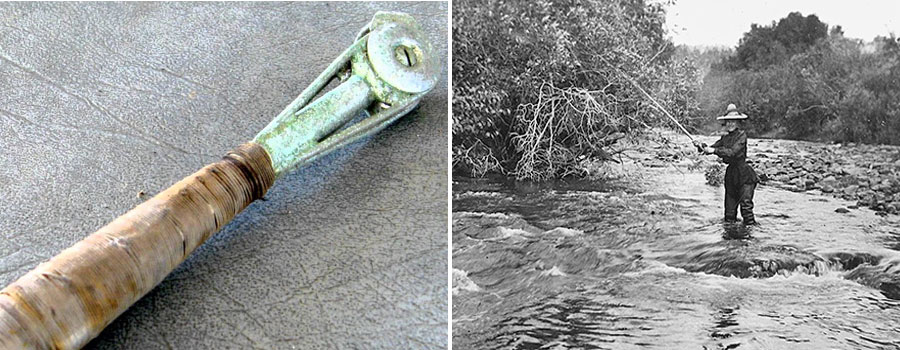
No matter how long a person lives, he will always search for food. One of the first methods of finding food is fishing. In this article, I want to tell you about the history of fishing rods. Because it is considered the most popular and widespread fishing tackle in human history. Its principle is extremely simple and intuitive even for a person who first took it in hand. Every day more than ten thousand rods of various variations are sold all over the world.
But how much do you know about the origin of this fishing gear? This question can often confuse even experienced fishermen. Meanwhile, the story of the fishing rod is much more complex and interesting than it seems at first glance. And I want you to know it too.
Fishing Rod History – Who Invented The First Fishing Rod
In Ancient times people fished using all sorts of tools. They were tridents, spears, and even primitive hooks made of stone, animal bones, and tree thorns. The fishing rod which is similar to the modern one was known to our descendants who lived about 30 thousand years ago.
The hooks found in the excavations were tied, apparently, to a fishing line which was used as lianas of plants, veins, hair of animals. Over time methods and tools for fishing were improved. It is difficult to say who exactly invented the first fishing rod. There are several versions of its origin.
Frescoes of Ancient Egypt contain paintings of people hunting for fish. Some of them have fishing tools in their hands that resemble modern fishing rods. The first mention of something like spinning fishing belongs to the ancient Greek author Theocritus. In his works, he mentioned fishing with a fishing rod. A deceptive bait was placed at the end of her line.
Two hundred years before the beginning of the new era, silk fishing lines and iron hooks were used in China. The latter appeared in Europe only in the middle of the iron age. In same China, one of its Emperors-Jing, who lived about 2-3 centuries. of our century wrote a note in which he outlined the technology of converting a sewing needle into a fishing hook and a method of fishing for rice grain.
But today the most common theory among experts is the “Northern” origin of the fishing rod. According to many researchers in the temperate and cold latitudes, there was a need for the invention of such a tool. Where there are fewer fish resources and it is more difficult to extract them.
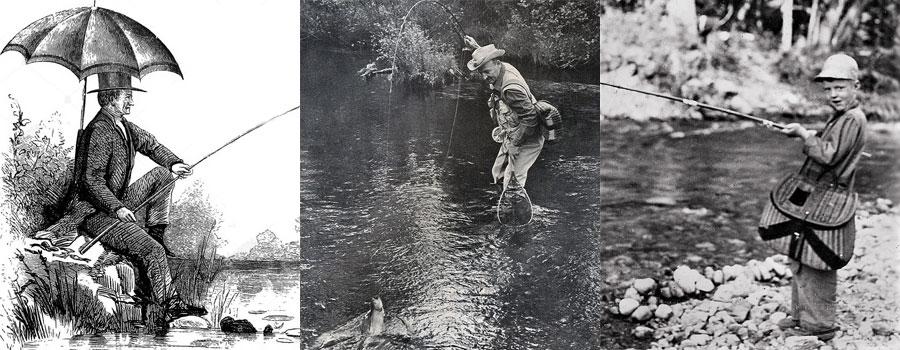
For fishing, they used a long string, at one end of which was fixed some kind of mollusk. It was usually a snail. As soon as the fish swallowed the bait, it was pulled out of the water. A familiar principle, isn’t it? Another mention of fishing with bait came to us from the ancient Greek epics by the authorship of Homer. He wrote about it in his Odyssey.
The first use of fishing rods marked a great advance in fishing techniques four or more thousand years ago. With the help of a fishing pole, it became possible to throw a hook with bait for a considerable distance. The fishing rod could be used without a fishing line.
The hook was tied directly to the top of the fishing rod. The ancient fishing pole was a flexible and strong whip (not to mention the bamboo fishing rods in Asian countries) which the fisherman himself cut and processed. For fishing rods, hazel was used most often, as well as willow, silver poplar, linden, larch, thorn, juniper, beech, ash, and spruce.
The last two breeds were used the longest. In the seventeenth century, the whalebone was used for the tip of the rod. A fishing rod made of bamboo was first mentioned in 1613 in foreign literature about fishing. The Romans already knew about fishing with fishing rods, which are collected from several parts. The dictionary “fishing” of 1772 gives information about folding fishing rods and, surprisingly, even about telescopic fishing rods and speaks about them disdainfully.
Doze f mentioned both (telescopic and collapsible with tubes) types of fishing rods from young straight-layer pine or spruce in his work in 1811. At the top, such a rod should have been thinner than the little finger. It was lengthened with a flexible rod of hazel or juniper, at the end of which was attached a loop of brass wire or hair for tying the line. This was done if desired. It contained detailed instructions on how to dry the rod stock, divide it into parts, and make connecting tubes.
Those who found it very difficult to make a collapsible fishing rod preferred to use a rod made of willow or hazel. At the end of the 19th century, steel rods of solid section and tubular appeared and in some cases the line was passed inside the tube. Steel rods came in all probability from America where they were very popular. While in Britain they appeared only in 1937. In Germany, steel fishing poles came into use before the great Patriotic war and were initially considered only as a replacement for expensive bamboo.
Expensive, overseas tree species were used to make fishing rods in the early twentieth century. Bamboo fishing rods had long existed. The word bamboo is a collective name for a large family of similar plants, but with different properties. In Britain, the first fishing rods were produced at the beginning of the last century.
Not only from bamboo, but also from other types of wood, including elderberry and rosewood. They were known as early as 1801. A significant step forward in the manufacture of fishing rods was made after the second world war. When new materials appeared. Fiberglass is a composite material with good strength and flexibility at the time.
The experience of using this material was used by Dr. Arthur Howald, technical Director of one of the American firms for the manufacture of fishing gear during the creation of fiberglass rods for sport fishing. In the 70s even more revolutionary materials appeared for the manufacture of rod blanks.
It’s carbon fiber. Carbon fiber rods were even lighter and stronger than fiberglass rods, although their price at first exceeded all reasonable limits. Fortunately, the development of technology has led to a significant reduction in the cost of such rods, now they are available to most anglers.
When Was the Collapsible Fishing Rod Invented
In the dictionary which was called the fisherman, you can find a mention of folding fishing rods. It was written in 1772. They may have appeared earlier. But now neither I nor you can find out exactly when. So I’m focusing on this year. A collapsible fishing rod had long been a luxury item. In Britain, the widespread production and use of folding fishing rods are due to the fact that fishing there became a mass character among the citizens in the 18th century.
They were unable to deal with long one-piece rods. It is important that a good bamboo fishing rod in those days was more expensive than the also expensive British folding fishing rod. But still, the best kind of fishing rod was a flexible hazel rod.
Types of fishing rods:
- Float fishing poles;
- Bottom fishing rods;
- Spinning rods;
- Fly fishing rods;
- Baitcaster rods;
- Non-system fishing rods.
Of all of them, the float rod is the most versatile tackle for fishing. A modern float fishing rod is a fairly complex tool that can be used almost the entire season of fishing in open water. It is used for fishing both in freshwater reservoirs with standing and running water: in lakes, ponds, reservoirs, in large and small rivers, streams. It is no less popular when fishing for sea fish.
It is suitable for feeding most species of fish. It is enough to equip it accordingly and you can catch both bleak or roach, bream, carp, and others. And predatory fish are no exception.
Float fishing rod consists of:
- Rod;
- Fishing line;
- Float;
- Sinker;
- Leash;
- Hook.
Why Did Fishing Appear?
For a long time, the most important way to search for food were hunting, fishing, and collecting edible fruits and plants. People settled near the water, near rivers, and on the coast of the seas. There were the first settlements. Therefore, the production of fish and seafood became for man one of the main conditions in the struggle for existence. Fishing is a very ancient occupation.
Perhaps, it has existed since the dawn of mankind. And in any case, fishing has helped humanity survive and preserve its kind in very difficult conditions to survive. But the fishing was interesting to people not only as a way to get food but also as a sport. It was still a thrill for them. In Ancient Greece and Ancient Rome, sport fishing was entertainment for aristocrats. This is stated by written sources.
Sport has developed all the centuries and is still developing. Now fishing is even more popular than in ancient times. Anglers from different countries of the world unite in fishing clubs, create their own bases and communities. In many countries, mass fishing competitions are organized, which introduce thousands of new adherents to this sport. There are also international fishing competitions.
On the market of tourist services, there are such directions as fishing Safari in places of exotic fishing, whether it is sea fishing of Marlin and swordfish or travel to salmon rivers in remote Northern areas. In our time fishing is a type of active recreation, a source of positive emotions, a mass sport, a means of hardening, and a way to communicate with nature.
Why Are Fishermen Called Anglers
Probably even people who are far from fishing have heard that some of the adherents of this type of active recreation call himself a fisherman, and someone an angler. Perhaps these words are synonyms that do not have semantic shades? This is not quite so. Let’s look at the terminology and find out exactly who the fisherman is and how it differs from the angler.
It is believed that fishermen and anglers have many differences. The first, for example, work mechanically and do not invent anything new, but the fishermen are so passionate about the process that they constantly use new equipment in fishing and read literature on the topic. So if you get up every Saturday at 4 am, go to the river with a fishing rod and call yourself a fisherman — this is not quite true, most likely you are an angler.
But this is a superficial difference. If you look deeper, the difference is that the “fisherman” is the name of the profession. Fishermen usually fish on an industrial scale or work as a private organization. This activity for them is a trade that ensures their existence. And the word “angler” in dictionaries is given a different definition: it should be used when it comes to a person’s hobby.
For the angler, the main thing is not getting a result or profit from the sale of fish, he is carried away by the process of fishing. The angler can fish with any fishing rod, dress in any clothes, be interested in new products and changes in fishing. He just loves and knows how to fish with varying degrees of efficiency, but the size of the catch does not depend on the level of his well-being. In general, “angler” is any person who catches fish.
Also, a fisherman can be called a captain seiner, and an ordinary sailor. They certainly will not be offended. The same name is given to representatives of certain nationalities, for whom fishing is a native and serves as a source of income and food for entire families. From a philological point of view, the words “fisherman” and” angler ” are paronyms. These words are similar in sound but different in meaning.
Advancements in Angling: The Advent of the Modern Rod 🏭
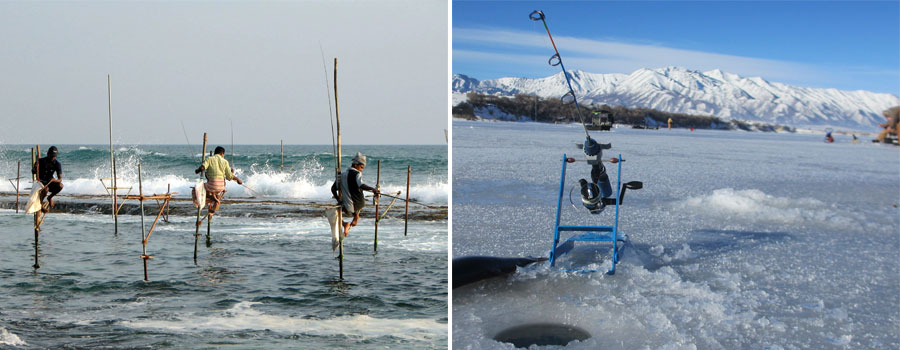
Turning the Gears of Progress: Fishing Poles in the Industrial Revolution
With the dawn of the Industrial Revolution in the late 18th century, the world of fishing saw a sea change. 🌊 The manufacturing innovations of the time transcended industries and inevitably swept into the realm of angling, fueling the evolution of the modern fishing pole.
The manufacturing of fishing rods was no longer a labor-intensive, time-consuming process restricted to skilled craftsmen. Machine-aided production made it possible to mass-produce fishing rods, making them more accessible to the general populace. The material palette also expanded, introducing metals like steel and iron into rod construction. However, it was another material that would truly revolutionize the fishing pole — split cane (or split bamboo).
Giants of the Deep: Hiram Leonard and Other Fishing Innovators
The introduction of split cane as a material for rod making was a turning point in fishing pole history. Leading the charge was an American entrepreneur and fishing enthusiast, Hiram Leonard.
Recognizing the limitations of conventional bamboo rods, Leonard initiated the construction of rods using split cane, which was bamboo carefully split into long strips and then glued together to form the rod. This process created a lighter, stronger, and more resilient rod, transforming the landscape of fishing forever.🎣💡
Leonard’s innovative spirit also gave birth to the Leonard Rod Company, one of the most influential fishing rod companies in history. It wasn’t just Leonard who left a mark, though; inventors like Everett Garrison further refined the split cane rod, enhancing its precision and performance.
Catch of the Day: The Impact of Modern Advancements on Fishing
These modern advancements shaped the world of fishing in unimaginable ways. The advent of mass-produced, affordable fishing rods made angling a popular recreational activity, accessible to people from all walks of life.👨👩👧👦
The superior strength, durability, and flexibility of the new rods also expanded the variety of fish that could be caught, opening up a whole new world of fishing opportunities. From freshwater fly fishing to saltwater deep-sea fishing, the modern fishing pole made it all possible. 🐟🌍
As the Industrial Revolution reshaped the fishing rod, the next phase in rod evolution was just around the corner. Brace yourself as we dive into the age of synthetic materials and explore the fascinating transformation from fiberglass to carbon fiber…⏭️
From Fiberglass to Carbon Fiber: The Evolution of Rod Materials 🧪

Charting New Waters: The Shift from Natural to Synthetic Materials
As the world moved towards industrialization, the fishing rod industry wasn’t left behind. A significant evolution was the transition from natural to synthetic materials. The discovery and development of fiberglass in the mid-20th century represented a new era in fishing rod construction. 🎣🔬
Fiberglass, durable and lightweight, brought a level of consistency and affordability that natural materials couldn’t. This change wasn’t just about material availability or cost-efficiency, but also about performance. The stage was set for another game-changing material—carbon fiber.
A Tale of Two Fibers: Fiberglass vs. Carbon Fiber
Fiberglass rods, introduced in the 1940s, were a breakthrough. They were cheaper, easier to produce, and more durable than their bamboo and split cane counterparts. However, they were stiffer and lacked the responsiveness that bamboo rods offered.
Enter carbon fiber (also known as graphite), debuting in the fishing industry in the 1970s. Carbon fiber rods were light as a feather yet incredibly robust. They offered a sensitivity that was unparalleled, allowing anglers to feel even the smallest nibble at the end of their line.🎣🪶
However, they were not without drawbacks. Carbon fiber rods were more expensive than fiberglass and could shatter if handled incorrectly. In contrast, fiberglass rods, although heavier and less sensitive, were almost indestructible and retained their popularity for certain types of fishing.
Changing Tides: The Impact of Material Evolution on Fishing
The shift from natural to synthetic materials has undeniably shaped modern angling practices. The lighter, stronger, and more responsive rods have allowed for longer, more accurate casts, and the ability to fight and land bigger, stronger fish. They’ve also made it easier for beginners to pick up the sport, as these rods are more user-friendly.👩🎓🎣
On the flip side, the rise of synthetic rods has brought about a certain nostalgia for traditional bamboo rods. Many anglers appreciate the craftmanship and “soul” of a bamboo rod and enjoy the different fishing style they promote.
As we can see, the journey of the fishing pole has been a fascinating one, shaped by both nature’s bounty and human ingenuity. As we look ahead, what could possibly be next for the humble fishing pole? Let’s reel in our curiosity and dive into the future of fishing pole technology…⏩
Technological Innovations: The Birth of Specialized Fishing Poles 🎣💡
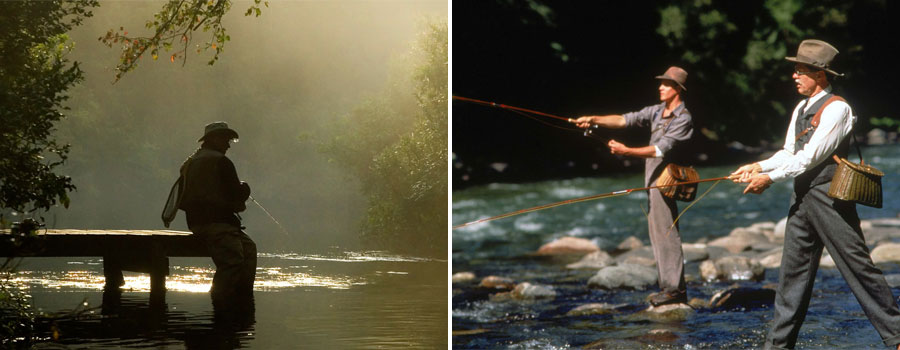
The Many Faces of Fishing: Fly, Spin, Troll and More
As the fishing rod material revolution carried on, another equally important transformation was taking place. The era of one-size-fits-all fishing poles was ending, giving way to an array of specialized rods tailored for various fishing techniques and species. This period saw the birth of fly rods, spinning rods, trolling rods, and many others, each designed with a unique purpose.🔧🌈
Tailor-Made Tackle: Unique Features of Specialized Poles
Fly fishing rods, for instance, are designed to be lightweight and flexible to accommodate the unique casting techniques of fly fishing. These rods often utilize the weight of the fishing line itself to achieve their casts, rather than a weighty lure. 🪰
On the other hand, spinning rods are built to handle a wide range of lure weights and are great for casting long distances. They are versatile and can be used for various fishing methods. 🎣
Trolling rods, typically the strongest and heaviest of the lot, are designed to drag bait through the water from a moving boat, aiming to catch big game fish. These rods need to withstand high loads and sudden impacts. 🚤
Each of these specialized rods came about for a specific reason – to enhance a particular style of fishing. Whether it was to cast lighter lures, handle bigger fish, or to cast further, each rod has a unique role in the angler’s arsenal. 🔭
Making Waves: The Impact of Specialized Poles on Professional Angling
The development of specialized fishing poles has had a profound impact on professional angling and tournaments. These rods have allowed anglers to push the boundaries of what’s possible in sport fishing.🏆
Specialized rods have opened up new competitive categories, each focusing on a unique aspect of the sport – fly fishing tournaments, trolling contests, surfcasting competitions, and many more. These innovations have not only changed the landscape of competitive fishing but also added to the thrill and enjoyment of the sport for both participants and spectators alike. 🎉
From a single bamboo stick to a varied arsenal of specialized rods, the fishing pole has truly come a long way. But as we’ll see, the journey doesn’t end here. As technology advances, so does the humble fishing pole. Let’s see what the future holds… 🚀
Looking Forward: The Future of the Fishing Pole 🎣⌛
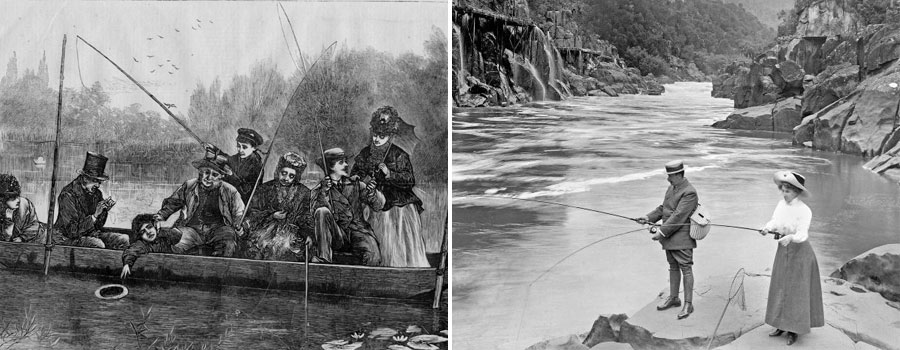
Reeling in the Future: Potential Advancements in Fishing Pole Design and Material
As we cast our lines into the future, we can only speculate about the potential advancements in fishing pole design and material. Given the current pace of technological advancement, it’s not far-fetched to imagine rods made from ultra-light, super-strong materials like nanotubes or graphene. Imagine a rod so sensitive that it can detect the heartbeat of a fish or a pole integrated with smart technology that can advise on optimal casting techniques! 🎣💡
The Cutting Edge: Current Research and Potential Breakthroughs in Fishing Technology
In the realm of current research, scientists and engineers are exploring advanced materials, electronics, and biomechanics to enhance fishing technology. We’re seeing early designs of smart rods equipped with sensors to provide data on water temperature, depth, and even fish movement. 🌊📊
Sustainable fishing practices are another area of focus. There are efforts underway to design fishing gear that minimizes environmental impact and reduces unintentional catch of non-target species. 🌍💚
The Fishing Pole in the Fabric of Society: An Ongoing Tale
Beyond its practical applications, the fishing pole plays a significant role in our culture and society. As an integral part of the angling tradition, it’s a tool that connects us to nature, offers a form of relaxation, and even fuels competitive sport. 🎣🏞️
As technology continues to advance, the fishing pole’s role may evolve, but its essence will likely remain the same. It will continue to be a symbol of our desire to explore, connect with nature, and challenge ourselves in the timeless art of fishing. 🚀🎣
Our journey through the history of the fishing pole has been an exciting voyage of innovation and evolution. As we look forward, we can’t help but wonder with anticipation about what the next chapter will hold. Stay tuned, fellow anglers, the best is yet to come… 📖🔮
❓ FAQ: The Fishing Pole’s Journey Through Time ❓
Conclusion: Unraveling the History of the Fishing Pole 🎣💭
From Simple Stick to Sophisticated Rod: The Fishing Pole’s Remarkable Journey
In this awe-inspiring journey through time, we’ve witnessed the fishing pole transform from a simple bamboo stick used by early humans 🌿, through the significant leaps during the industrial revolution with inventors like Hiram Leonard ⚙️, to the modern marvels of fiberglass and carbon fiber rods 🚀. Each stage of development was fueled by our constant pursuit of better angling, an endeavor that expanded into the creation of specialized poles, tailored to suit various fishing techniques and species 🎣🌈.
Reeling in the Lessons: Key Takeaways and Parting Thoughts
As we cast our line across the history of the fishing pole, several key insights surface:
- The evolution of the fishing pole is a testament to human ingenuity and our relationship with nature 🏞️💡.
- Each advancement, from material choice to design, has been about enhancing our fishing experiences and efficiency 🛠️🎣.
- The emergence of specialized poles reflects the diversity of angling techniques and the broad appeal of fishing across cultures and regions 🌎🎣.
- As we move forward, it’s exciting to see how advancements in technology and sustainability will continue to shape the future of fishing poles 🚀💚.
As a fishing professional, I look back at this journey with profound respect and look forward to the thrilling prospects that await us. The fishing pole, a seemingly simple tool, carries a rich history and a promising future. As we reel in our lines and pack away our gear, let’s remember the essence of fishing – a dance with nature that, much like our beloved fishing poles, continually evolves and enchants.
Here’s to the next cast, and to all the adventures that lie ahead! 🎣🏞️🌟
Source Trails: Following the Stream of Knowledge 📚🔍
For those wanting to cast their line further into the fascinating history of fishing poles, I’ve compiled a list of reliable sources and engaging reads. These materials provided the foundational research for this article and serve as great starting points for your own exploration 🎣🔖.
- Schullery, P. (1996). American Fly Fishing: A History. New York: The Lyons Press. 📘
- Waterman, C. (1996). Black Bass & the Fly Rod. Stackpole Books. 📘
- Garner, P. (2018). Evolution of the Modern Sports Fishing Rod: Material, Design, and Engineering Applications. Journal of the Mechanical Behavior of Materials. 📄
- Greenhalgh, M. (2007). Fishing’s Strangest Days: Extraordinary But True Stories from Over Two Hundred Years of Angling History. Robson. 📘
- American Museum of Fly Fishing. (2021). History of Fly Fishing. 🌐
- International Game Fish Association. (2021). A Brief History of Recreational Angling. 🌐
Each source offers a unique perspective on the evolution of the fishing pole and the rich tapestry of fishing’s history. So grab a cup of coffee ☕, settle into your favorite reading spot, and delve into the captivating world of angling history. Enjoy the journey! 🚣♂️📚
Tags: #true temper fishing rod history / #jarvis walker fishing rod history / #fishing rod history timeline / #fishing rod history / #garcia fishing rod history

I live in Tenerife (Canary Islands) for the last 10+ years and share my daily fishing experiences on my website. Many years of personal experience as a fisherman and the vast experience of my friends allow me to write professionally on any fishing topics (from choosing a flashlight and equipment to deep-sea fishing).
All of my advice is based on practical real-world experience and will be useful to both novice anglers and professionals. Read more about the author.
Affiliate Disclosure: FishReeler.org sometimes gets paid for listings, through sponsors or affiliate programs like Amazon, Ebay, Cabelas, Bass Pro Shop, Shimano, Daiwa, Rapala, Renn, Okuma, KastKing, etс. Clicking a link helps keep FishReeler.org free, at no extra cost to you!
About the author: Each article is verified by the fishing expert Sergio Smirnoff. The articles are written by professional and amateur fishermen with 20+ years of fishing experience.
Note: The views and opinions expressed in this article are those of the authors and do not necessarily reflect the official policy or position of any agency. The articles are for informational purposes only, share your opinions in the comments and join the fishing discussions, let's share our fishing experiences together!


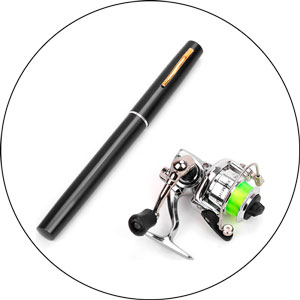

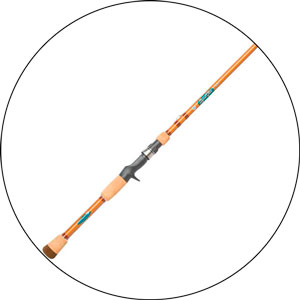
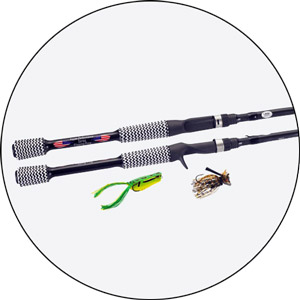
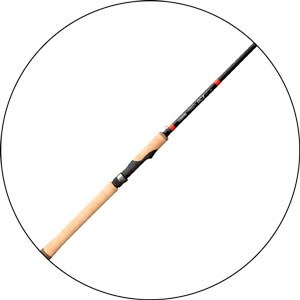
Awesome read! I didn’t know there were so many different types of fishing poles. Thanks for the education.
The history of fishing poles is a testament to human ingenuity and the love for fishing. Thanks for shedding light on it. I have conducted extensive research on the history of fishing and have discovered numerous sources. Most of the information is centered on fishing as a means of obtaining food and while useful for some aspects of my story, I am looking to gather more information on fishing as a leisure activity.
Many sources mention the existence of fishing rods and hooks as early as x000 BC but also mention that the development of reels took place much later in medieval times. Does this imply that fishing rods during this time consisted simply of a long rod with a line tied to its end, accompanied by a hook?
Yes, this does imply that early fishing rods consisted of a long rod with a line tied to the end and a hook attached to the line. Reels were not yet in use during this time period.
Very informative article, I learned a lot about the evolution of fishing poles. Great job!
I was fascinated to read about the ancient methods of fishing and how it has evolved over time. Thanks for sharing.
Interesting to see the progression from simple bamboo sticks to the advanced technology in fishing rods today.